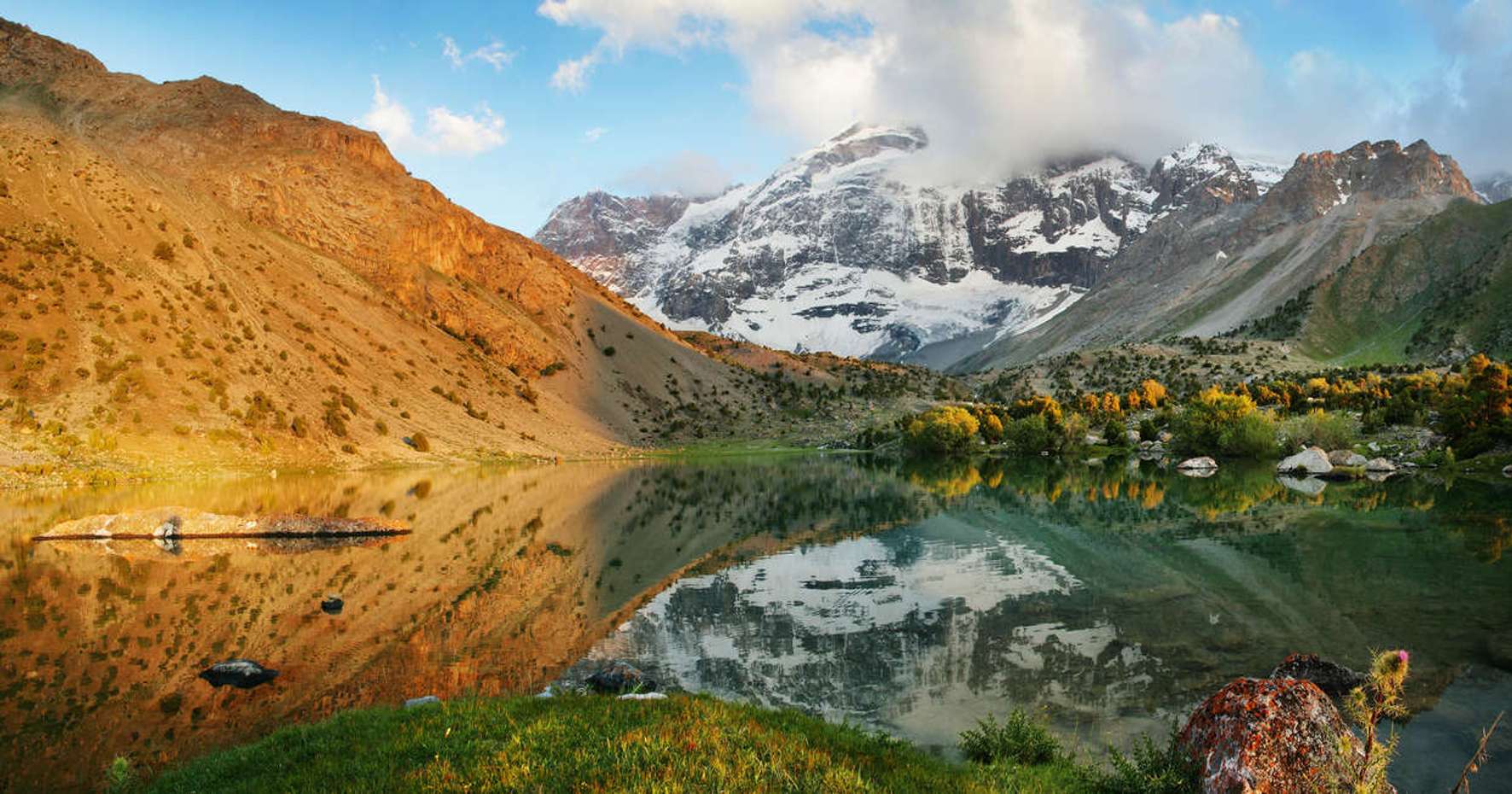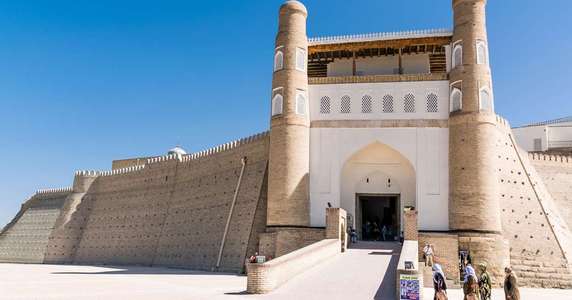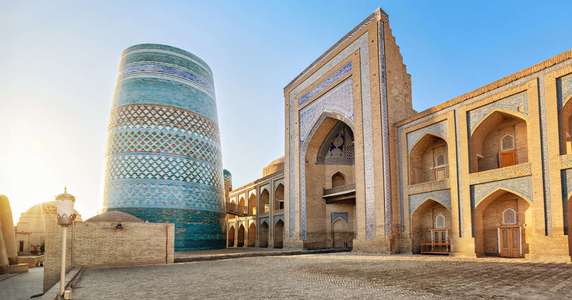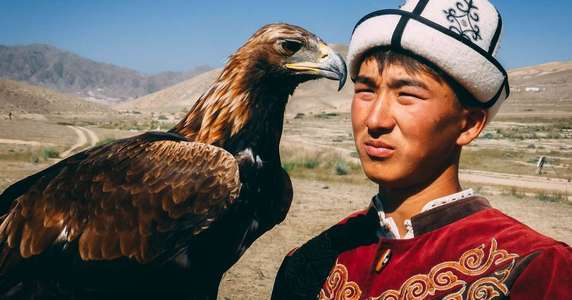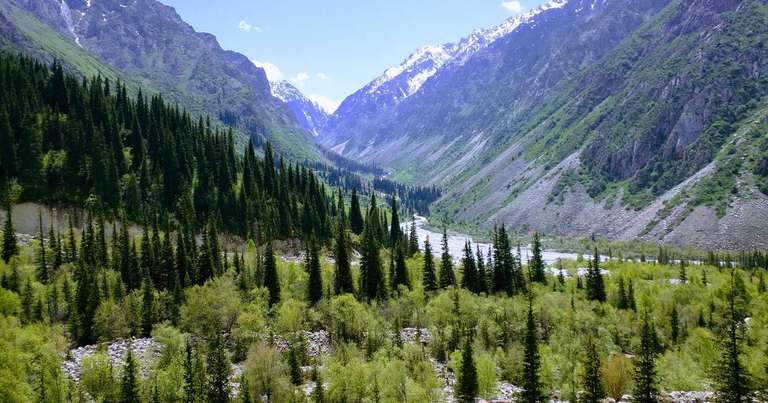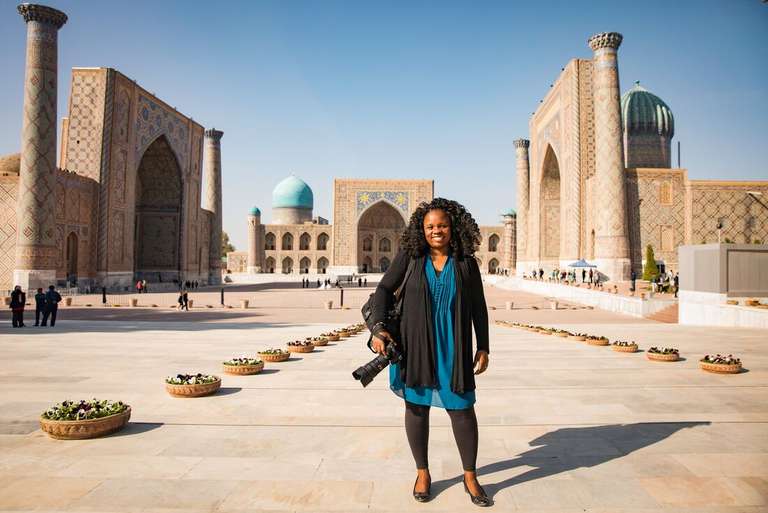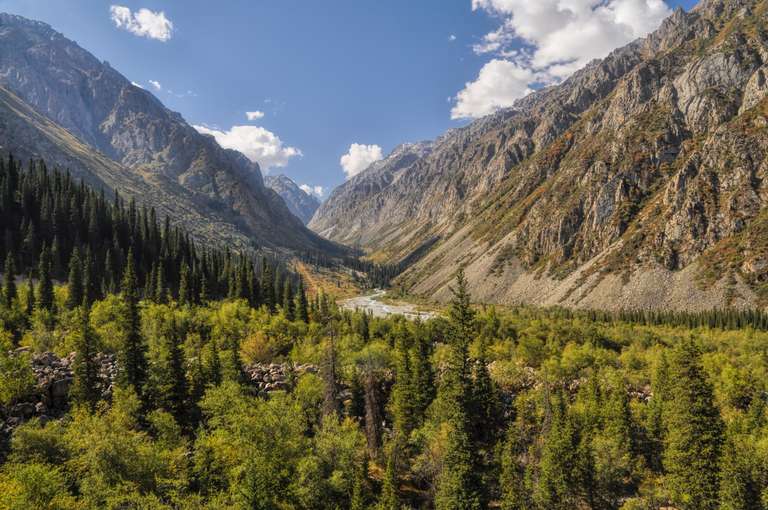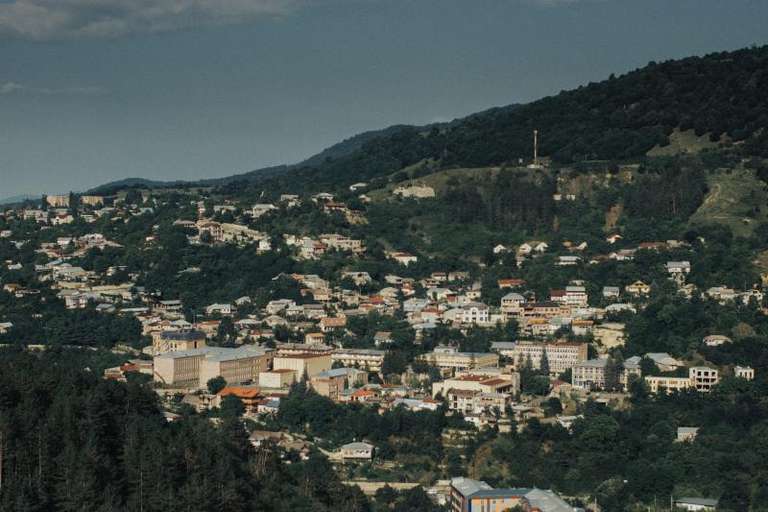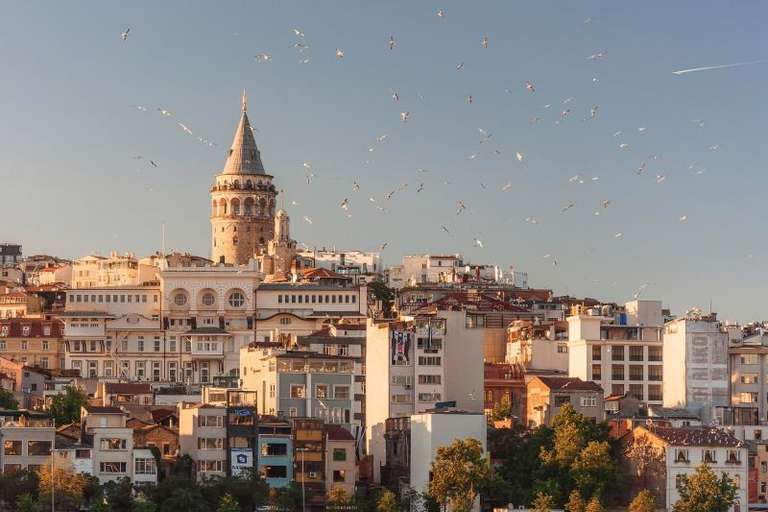Highlights
An epic 3 week journey through the Silk Road highlights of the fabled Five Stans
Walk amongst wild mountain scenery in the Fann Mountains
Discover the ancient cities of Khiva, Bukhara and Samarkand
Itinerary
Traverse mountains pocketed with turquoise alpine lakes, drive through lush fertile valleys and zip across dry and dusty desert plains by high-speed train. This is an all-encompassing, ever-changing journey through the 5 'Stans of Central Asia.
Fann Mountains - Walk amongst wild mountain scenery and snap the picture-perfect 'Seven Lakes'.
The Silk Road - Travel along ancient routes and discover the intricate architecture of Khiva, Bukhara and Samarkand.
Lake Issyk Kul - Sleep in a traditional yurt by the shores of 'The Pearl of Kyrgyzstan'
day 1 - Join trip in Bishkek and have an afternoon exploring the city
Our tour starts today in Bishkek, a former Silk Road settlement. Kyrgyzstan's capital is a young city, starting life as a clay fort built by the Khan of Kokand in 1825, only to be destroyed by the Russians 43 years later and rebuilt in 1878.
For those arriving on time today, our tour leader plans to meet you in the hotel reception at 11am for a welcome meeting, followed by a sightseeing tour by bus and on foot. We'll learn about the main monuments and buildings of the city and take a leisurely walk through Oak Park.
If you'd like an airport transfer today, you'll need to arrive into Manas International Airport (FRU), which is a 40-minute drive from the hotel. For those arriving on flights in the early hours of this morning or for anyone arriving before today, please contact us to book additional nights' accommodation.
Please note that if you'd like to join the Bishkek city tour today, you'll need to arrive at the hotel by 11:30am. If you're booking your own flights, we recommend giving yourself at least one hour to clear the airport. From the airport to the hotel is around a 40-minute drive, so the latest your flight can arrive is 9:30am. If you miss the welcome meeting, your tour leader will inform you of any essential information at 6:30pm this evening, or 8:45am the morning of day 2.
day 2 - Drive to Burana Tower and visit a stadium for horse games. Drive onto Chon Kemin and learn how to make Kyrgyz fried bread
Leaving Bishkek behind this morning, we first drive out to Burana Tower; a piece of Silk Road history that sits sequestered in the wide-open landscape. The 11th-century tower is all that remains of the ancient city of Balasagun, with the tower itself half the height of its former glory. We continue to Tokmok stadium, which plays host to the wealth of horse games that have remained hugely popular here throughout the centuries. We will witness a demonstration of Kok Boru, a form of polo played with the carcass of a goat, and Oodarysh which literally translates to 'wrestling from horseback'.
We arrive in Chon Kemin in the afternoon, where our home for the night is a quaint guesthouse in the middle of a peaceful valley, covered with green meadows that are full of wildflowers in spring and early summer, while forests of fir trees cloak the higher slopes. This evening, we will embark on a masterclass to learn how to make Boorsok, the national bread and one of the country's staple foods. The doughy mixture is deep-fried in large quantities before being spread across the 'dastorkan' or table, doubling as a table decoration. Cooking an abundance of Boorsok is seen as a sign of generosity on the part of the host, so seldom will you see a dinner table not chock-full of tasty offerings.
day 3 - Drive onto Lake Issyk Kul to sleep in a yurt
After breakfast, we'll wind our way to the iconic Lake Issyk Kul, quite rightly dubbed 'The Pearl of Kyrgyzstan'. We trace our way alongside its southern shores to the village of Kyzyl Tuu, one of the centres for yurt production. Here we learn more about how these fascinating structures work and why they have been the chosen dwellings for Central Asian nomads for centuries.
We'll also have the chance to visit a local cooperative producing the two traditional types of Kyrgyz felt carpets, Ala-kiyiz and Shyrdaks. Our final stop of today's journey is in Bokonbayevo where we meet an Eagle Hunter. Here we will see how this form of falconry has been practiced and perfected over centuries.
We arrive at our yurt camp, on the banks of Lake Issyk Kul in the late afternoon, where there will be time for swimming in the lake before dinner. Tonight's yurts will be twin-share with western-style toilets and cold showers available.
day 4 - Explore Skazka Canyon on foot and then drive onto Karakol for a city tour
After a leisurely breakfast overlooking the shores of Issyk Kul, we'll drive on to Skazka or 'Fairytale Canyon', so-called due to the bizarre landscape of captivating rock formations. The rock formation in this area is a deep-red sandstone that rises out of the green valley below, offering quite a different landscape from that which we have seen so far. After a short walk here, we'll continue to the town of Karakol, where we'll meet civilisation once again.
Embarking on a tour of the town, we'll discover some of its most interesting sights, including the Dungan Mosque which was built in 1904 without using a single nail and serving as a place of worship for the country's Chinese Muslims. The architecture is quite striking, foregoing minarets and opting instead for a wooden pagoda-style roof. We also see the Russian Orthodox Church which was constructed entirely of wood in 1869 and is still standing today. Finally, we'll visit the museum of the Russian explorer Przkevalski, after whom the town was originally named. From here, we'll make the short drive out of the city to the village of Tepke, where we spend the night in a farmer's guesthouse.
day 5 - Cross the border into Kazakhstan and explore Charyn Canyon before driving to Almaty
Bidding goodbye to our hosts this morning, we'll set off for our next country, Kazakhstan. Our route takes us up to the tip of the eastern Tien Shen range when we cross the border at Kegen before descending to the dry, dusty and hot Kazakh steppe. We stop at Charyn Canyon, often compared to the Grand Canyon albeit on a smaller scale. We visit a part of the canyon known as the 'Valley of Castles' due to its unusual rock formations, and from here we descend 100 metres from the rim down to the river where we have a picnic. It's possible to dip your feet in the river for those who feel in need of a cool-down.
After returning to the road we continue onto Almaty where we aim to arrive in the early evening.
Almaty ceded capital status to Astana in 1997, but it still remains the cultural and financial centre, where Russians, nomadic Kazakhs, Kyrgyz, Tartars and many other ethnic groups rub shoulders in its bustling markets. The city has an almost European feel, partly due to the earthquake in 1911 that flattened Almaty resulting in the complete re-planning and re-building of the city. Wide, leafy boulevards were constructed and lined with low-rise white-washed housing and offices, and the few period buildings that remained intact were restored to their former glory. The city enjoys an enviable position, nestled in the foothills of the Zailiysky Alatau range, with beautiful turquoise lakes, snow-capped mountains and chic ski resorts just a short drive away.
day 6 - Tour the wide boulevards and green parks of Almaty
Today we set out to explore some of the Almaty's major sites, starting in the Park of 28 Guards. The park is diverse, serving as a popular meeting place for locals as well as housing a variety of important monuments and buildings. The park's focal point is the Ascension Cathedral, a beautiful Russian Orthodox-style cathedral and one of only two wooden buildings left in the city. Also found in the park are imposing Soviet statues remembering falling soldiers from campaigns such as WW2 and the Afghan War, where many Kazakh nationals fought to support the USSR's interests.
We then move on to Green Market, a fascinating meeting place for the city's locals to come for their daily shopping. The market offers an eclectic range of produce brought by nomads as far-flung as Korea, all the way through China and Central Asia. Here you can find exotic fruits, and vegetables, an extensive butchery section with all types of meat and a wide variety of savoury foods. Make sure to try Kazzan (smoked horse sausage) and Kurt (salted cheese balls popular with beer).
The rest of the afternoon has been left free to relax, or further exploration. You could take a taxi up to the Medeo ice rink, then travel by cable car to the top of the Shymbulak skiing area for superb views of the city and the surrounding mountains.
day 7 - Morning flight to Dushanbe. Afternoon orientation tour of the city
This morning, we'll take a short flight of around two hours to Dushanbe, Tajikistan's enigmatic capital. The capital of Tajikistan shares little history with many of its great Silk Road counterparts, with most evidence pointing to the fact Dushanbe was a small village until the turn of the 20th century. The city gained prominence when Tajikistan became part of the USSR, with the Soviets establishing the city as a centre for textile production. It was then that the city began to grow, and more recently it has reached the end of a 10-year intensive building programme bringing the city into the 21st century.
This afternoon we will explore some of the city's main highlights, starting the tour at the National Archaeological Museum of Tajikistan. Here we find its famous Buddha statue and rich collection of archaeological artefacts along with collections of fine art. We continue onto the statue of Ismail Samani, the large monument that commemorates the 1,100th anniversary of the Samanid State, which by many is considered to have been the heyday of the Tajik nation when science and arts flourished. Time permitting, during the city tour we will have the opportunity to visit the Museum of Antiquities, particularly famous for its murals from Penjikent. From there we walk up to Rudaki Park, dedicated to the great Persian poet Rudaki, who also lived during Samanid time in the 9th century AD.
We end the day with dinner in a local restaurant serving traditional Tajik cuisine. A typical meal in Tajikistan would include vegetable salad starters, followed by a hearty soup similar to the Russian borsch, and a main consists of a meat dish like shashlik or chicken served alongside freshly baked bread.
day 8 - Further exploration of Dushanbe including Navruz Palace and the market
Today is a more relaxed day with some time for further exploration of the city. We will visit the strikingly beautiful Navruz Palace, Dushanbe's gleaming centrepiece. Hundreds of skilled artisans were appointed to work on the building, with it initially being planned to be built as the largest tea house in the world. But when its interior frescoes and mosaic walls turned out to be so impressive, it was instead turned into a palace. We will also pay a visit to the Museum of Musical Instruments, which, in stark contrast to the palace, is hosted in the front room of a local house! Ran by passionate local Iqbol Zavkibekov, the museum is packed with a rich collection of Pamiri, Tajik and Central Asian musical instruments. Here Iqbol carries on the legacy of his father, a famous Tajik musician, by demonstrating how these traditional instruments are deeply ingrained into the nomadic culture of Central Asia.
This afternoon has been left free to relax, or perhaps to take a walk through the city's central market to try and barter for fruit, clothes or textiles.
day 9 - Full day drive into the Fann Mountains. Picnic stop for a scenic lunch and walk to a waterfall
We set off early this morning for a scenic drive into the mountains. Our first destination is Iskander Kul, named after Alexander the Great. Triangular in shape, it is often considered to be the most beautiful lake in all of the former USSR. Standing at an altitude of 2,200 metres, this alpine lake is nestled in the heart of the Fann Mountains and set to a backdrop of snow-capped peaks. We stop on the shores of the lake for a picnic, and we take a short walk to a nearby waterfall before continuing the drive to Penjikent, aiming to arrive in the early evening.
The accommodation for the next two nights is a simple but comfortable hotel with twin rooms and en-suite bathrooms.
day 10 - Drive to the 'Seven Lakes' for a half day walk among the picturesque lakes
We will spend a full day in the mountains today, exploring the region of the 'Seven Lakes'. Legend has it that the lakes were formed from the tears of seven daughters after the loss of their father. The father got lost in the valley and after several days of looking, it was clear they weren't going to find him. The upset and anguish caused had their tears fill up the valleys right where they were looking. What is for sure is that each of the glacial lakes takes on its own form, with their names thought to reflect their individual shapes. Some are set deep in valleys, others wide and on an open plain. Sometimes the appearance of even the same lake can change as the light and cloud cover transforms throughout the day, with the colours changing from blue, to turquoise, to green and black.
We have a picnic lunch beside the fourth lake 'Nofin', before driving further up the valley to the sixth lake 'Marguzor'. It is from here we embark on an hour-long hike up to the seventh and highest lake, Hazorchashma. It's worth the walk, but for those not wishing to make the two-hour round trip, it is possible to just relax on the shores of the sixth lake.
Later in the afternoon, we return by bus back to Penjikent for our last dinner in Tajikistan.
day 11 - Drive to historic Samarkand to discover Registan Square and Gur Emir Mausoleum
Leaving Penjikent behind this morning, we head west and make for the border and our fourth country, Uzbekistan. Before crossing we stop off at the UNESCO site of Sarazm, dating back to the 4th century BC and bearing evidence of one of the first settlements in Tajikistan, possibly even Central Asia. Continuing onto the border, we cross on foot before picking up our Uzbek bus and making the short drive onto the much-fabled city of Samarkand.
Stormed by Alexander the Great and reduced to ashes by Genghis Khan, Samarkand was nevertheless transformed into the most glittering city in Transoxiana by Tamerlane, who made it his capital in the 14th century. Even today, the monumental scale of the buildings overwhelms visitors. This afternoon, we will visit Registan Square, Samarkand's turquoise mosaic masterpiece. Registan's sweeping public square is flanked on three sides by huge intricately tiled madrasahs. Meticulously restored during Soviet times, it now echoes its former glory, and we will spend time taking in the scale of the monument, as well as learning about its role over the six centuries it has been standing. We will also visit the Gur Emir, the gold-ceilinged tomb of Tamerlane himself, revered as somewhat of a national icon in Uzbekistan.
day 12 - More highlights of Samarkand and free time in the afternoon
This morning's sightseeing is accompanied by a local guide who will take us to the Shah-i-Zinda - a beautifully tiled necropolis of tombs, mosques and mausoleums belonging to Tamerlane's family, friends and the prophet Mohammad's cousin. We will also visit the Ulug-Beg Observatory, considered to have been one of the finest observatories in the Islamic World. It was here that Ulug-Beg, the great medieval astronomer, built his gigantic sextant which enabled him to calculate the length of a year within just 10 seconds. The tour will include Bibi-Khanym Mosque, once the largest in Central Asia; it was built by Tamerlane with loot from Indian campaigns and named after his favourite Mongolian wife. Finally, a visit to the Konigil Paper Mill which is located on the outskirts of the town.
The rest of the afternoon is free for further exploration at your own pace or relaxation.
day 13 - Morning train to Bukhara, discover blue-tiled domes and minarets; learn about the city's history
After breakfast this morning we will head to the train station to take the high-speed train to Bukhara, a comfortable journey of just under two hours travelling at over 250kph.
Bukhara was a key trading post on the Silk Road. This UNESCO-listed city has many zig-zagged backstreets, bustling bazaars and historical monuments. Many call it "Bukhoroi Shareef", translating to Holy Bukhara on account of its hundreds of mosques and mausoleums. The city has seen various dynasties battling for influence as it has always stood as a centre of trade, culture, and scholarship.
Today's afternoon of sightseeing starts off with a walking tour. Highlights include the Lyab-i Hauz which once supplied the city's water; the striking blue-tiled Abdul Khan Madrasah and the 9th-century Mghoki Arrar Mosque. We will also visit the Kalyan minaret, which, as the tallest monument in town, is known as the 'Tower of Death' because prisoners were once hurled to their deaths from here. In addition, we will take in the trading domes that are the most famous symbol of Bukharan architecture.
day 14 - Another day exploring Bukhara
We continue our city tour in the old town of Bukhara. A short drive will take us to The Ark - a massive citadel which was used as a fortress from the 5th century until it fell to the Russians in 1920. Today it houses several small museums connected with Bukhara's history. Bokhara was the site of the imprisonment of two British soldiers during 'The Great Game' - an epic battle fought between Victorian Britain and Tsarist Russia across the vastness of Central Asia. Moreover, we will take in the Char Minar Mosque - the impressive entrance to a now-demolished madrassah, and wander the backstreets of the old town maybe stopping off for a 'chaikhana', at a local tea house.
In the afternoon you may visit the Mausoleum of Naqshbandi, 15 km outside the city centre. There are many orders in Sufism, all of which have been represented at different times in what is now Uzbekistan. The Naqshbandiyya order has a great and long-lasting influence, and the memorial place is still a popular place of pilgrimage for Sufis. From here, we will visit the summer residence of the last Emir of Bukhara. In Persian, it is called Sitorai Mokhi Hossa, the place where the moon meets the stars.
This evening we enjoy our last dinner in this well-preserved ancient Persian city.
day 15 - Drive from Bukhara to Khiva
After breakfast and check-out, we will say goodbye to Bukhara. The road to Khiva is certainly a long but scenic one, taking us through the Kyzylkum Desert. We will cover a distance of approximately 450km in about 8 hours, with key stops for rest and lunch along the way.
At the end of this lengthy drive, we will be rewarded with the magnificence of Khiva. Its history is more than 2,000 years old and it is one of the best preserved Islamic cities of Central Asia, its structure and roads are mostly intact making it easy to imagine how the city looked from the 10th century onwards.
Dinner in the Old City and check in at our hotel for some well-deserved rest.
day 16 - A full day wandering the narrow streets of the 'Open Air Museum' of Khiva
On this morning's walking tour, we may well feel like we are stepping into a scene from the film 'Arabian Nights' as we explore the majestic Old Citadel. This 12th-century fortress dominated the city before a palace, harem, barracks and mosques were constructed. It is worth climbing the steps of the Dzhuma Minaret for a panoramic view of the maze of streets below.
The rest of the afternoon has been left free to explore the mosques, tombs and palaces of this well-preserved city, which has hardly changed since ancient times. This evening, you may choose to explore a bit more of the city after dark, when magical moonlit silhouettes make it even more spectacular.
day 17 - Free day in Khiva; Optional half day trip to the desert fortresses
Today we will spend another full day in the magnificent Silk Road oasis of Khiva. You have free time to wander out, sit by the minaret in the shade and drink tea, or spend your time hunting for handmade souvenirs. Your guide is available for you all day to suggest things to do and places to see and they may also join you.
Enjoy your last day in Uzbekistan and recharge your batteries to be ready for the adventurous next couple of days in Turkmenistan.
For those willing to explore a bit more, there is a chance to take an optional half-day trip with a local guide to visit the ancient Khorezmian settlement ruins. Among the highlights, are Toprak Kala, the ancient palace city and Ayaz Kala, a settlement ruins located on a hilltop.
day 18 - Cross the border into Turkmenistan and drive onto Darvaza to camp by the flaming crater
We set off for the border in Shavat-Dashoguz this morning to cross into our fifth and final Stan - Turkmenistan. The border crossing into Turkmenistan can sometimes be a lengthy affair, so be prepared for a 2-3 hour wait and a thorough search of all bags. It is here we will wave goodbye to our Tour Leader at the Uzbek border, before making our way on foot and by bus across no-man's land to be greeted by a local Turkmen leader for the final few days of our trip.
From here we continue on into the Karakum desert for a six-hour drive to the incredible Darvaza Crater. Many stories surround the so-called 'Door to Hell', the one that most people settle on was that the site was identified by Soviet engineers in the early 1970s as an oil site. Drilling commenced before they hit a gas pocket which caused the collapse of the rig into the crater we see today. Dangerous amounts of toxic gas began to be released, so it was decided to try and burn the gas off by settling it alight. It remains alight today, over 50 years later.
After a very apt barbecue dinner, we'll have plenty of time to take in Darvaza's deep reds, oranges, and crimsons as it burns brightly against the backdrop of the inky-black sky.
We camp tonight beside the crater in two-man tents. The set-up is very simple, with permanent toilets but no access to showers. All mats and bedding will be provided.
***The fire within the Darvaza Crater is gradually burning out, and the gas flow has significantly decreased in recent times. We are monitoring the situation and will inform you of any changes to the itinerary in due course***
day 19 - Continue onto Ashgabat, stopping via the Erbent Desert community
Continuing south this morning, we stop via the Erbent Desert community. The most remote part, of one of the world's most remote countries is an odd place to find a village, but this small, hardy community thrives here against all the odds. We spend some time wandering among the small village's houses and yurts and learning how the villagers here have adapted to such an extreme environment.
We continue onto Ashgabat, arriving in time for lunch.
The capital of Turkmenistan was a once-prosperous frontier town along the Trans-Caspian railway that was completely destroyed by a massive earthquake in 1948. It rose from its ashes and rubble and became the capital of an independent Turkmenistan in 1991. The city then became the personal project of President Niyazov, who set about forming it in his own unique image, renaming the streets and changing the face of the city on an almost daily basis as he approved the destruction of its suburbs to make way for several controversial planning projects. In the afternoon we have an opportunity to explore the city on a tour that will take in some of the highlights of both the Soviet and Niyazov reigns. We visit Independence Park where we will see the Independence Monument, a large structure designed to resemble traditional Turkmen hats. We will also pay a visit to the Turkmenistan National Museum of History, a rich cache of some 150,000 objects and artefacts that date back to Neolithic times and the Bronze Age era of the Margiana civilisation.
day 20 - In Ashgabat, visit Nisa Fortress and Gypjak Mosque
This morning, we drive out to the outskirts of the city to the once-mighty fortress of Nisa. Founded in the 3rd century BC as the capital of the 1st Parthian Empire, its walls, and towers (43 in total) protected the royal palace, Zoroastrian temples and the power and prestige of successive ruling dynasties until its eventual destruction at the hands of the Mongols in the 13th century. We then continue on to the impressive Gypjak Mosque or spiritual mosque. The largest mosque in Central Asia, it was constructed in 2002 for a reported sum of $100 million and mirrors the style of much of the city with its opulent white marble walls and golden domes. After some time for exploration, we return to the city, where the rest of this afternoon has been left free.
day 21 - Trip ends in Ashgabat
The trip ends after breakfast at our hotel in Ashgabat.
There are no activities planned today, so you're free to depart from Ashgabat at any time. If your flight is departing later in the day, luggage storage facilities are available at our hotel. If you'd like an airport transfer today, you'll need to depart from Ashgabat International Airport (ASB), which is a 40-minute drive from the hotel.
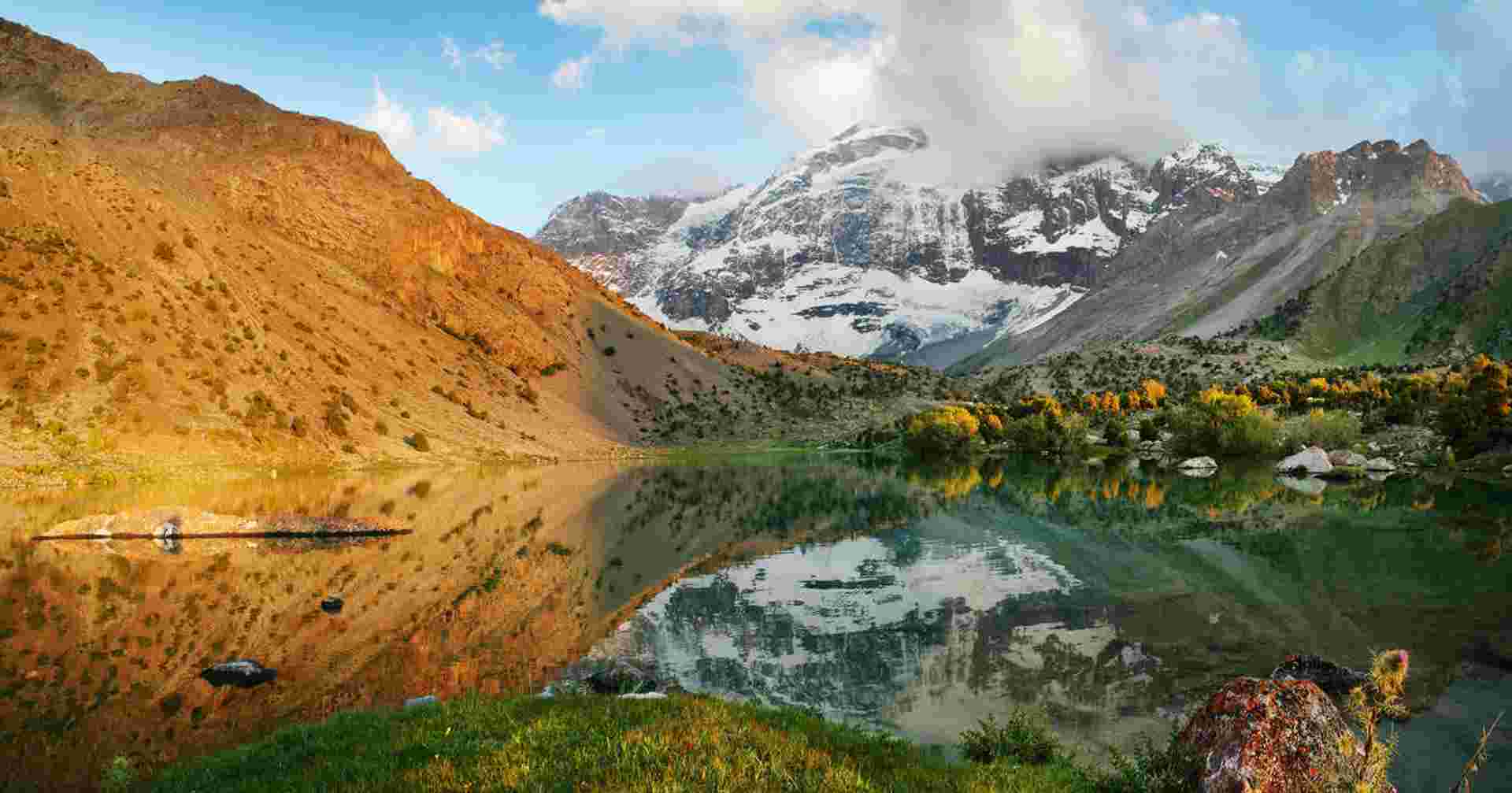
Get Trip Brochure & Exclusive Discount
Download a detailed PDF brochure and unlock an exclusive discount for this tour
What's Included
What's Excluded
Customer Reviews
Read what other travelers have to say about The Five Stans of The Silk Road
The leader was excellent, caring and very helpful. Easy to talk to and always trying his best to satisfy the group. We recommend him very highly. The worse experience we had in Turkmenistan, starting immediately after crossing the borders with Uzbekistan, being kept on the border for 5 hours waiting for the bus and being pushed out by the locals. Then the border was closed for the boarder staff’s lunch for the other 1.5 hours. All experience was massy, chaotic and lengthy. Then there was a very long trip through the desert on a so bad dirty and dangerous road with cars driving in all directions trying to avoid the deep holes in the surface. We arrived so late at the camp after sunset., around 9:30 pm, where was so cold, dark and windy, the food was horrible and we were sleeping in the dirty, sandy tents in the dirty sleeping bags instead of the yurts, there was no clean toilet to use. I think that the experience of Turkmenistan should be skipped as there was nothing interesting to see there. The white city, Ashgabat was so artificial that I would not recommend anyone to go there. There was no good feeling about this city. I think that this country can be easily missed all together and the trip could be extended by the longer stay in Uzbekistan and Kazachstan. The other thing that we were so upset about was our arrival to the Bishkek Airport on the early morning at about 2 am on 22/09. We booked and paid for an additional night - 21-22 /09/25 at the hotel and for the transfer from the airport to the hotel for 4 people but the transfer never arrived. We were left stranded and alone at the airport in the middle of the night not able to get to the hotel. Thankfully to another kind and helpful Explorer’s participant who arrived from USA we were taken to the same hotel. It turned out that nobody from Explorer company knew or was aware of our earlier arrival even though it was confirmed by our agent here in Melbourne. Definitely we were not happy customers on that night. There were other problems relating to food shortages and quality causing all participants to have gastrointestinal issues some more severe than others. I feel that for this amount of money we paid for our trip the conditions should be of a much higher standards.
It has been quite long since the tour. I made notes when I got home but they have been lost in the shuffle which brings me to my first suggestion/comment…d •Surveys: We were told we would be getting a trip survey right after the tour. It never arrived. I booked thru a third party and you knew I was a participant on the tour. I would recommend you send the trip survey to all tour members – whether they booked with you or not. I would also like to know who gets to see the reviews. Now that I see the question about using my data for a public review, I will say that this was written as suggestions for Explore. I would leave a completely different review for public display. •Guides: The guides were excellent, especially Sanjar and Begaiam. But having said that, Tipping was still too exorbitant. I don’t remember the percentage to drivers and to country guides. •Tipping #1: You say you pay your people well. I was very surprised the first day when we were asked for $80 US cash for tips to drivers and country guides. I had not factored this into my US cash allowance. Our name was checked off when we paid and we were reminded until it was paid. I expect tipping to be done by pass the envelope when the person is done. Tipping is not an automatic and the premise is to pay for exceptional service – not for doing your job. •Tipping #2: Similar – pass the envelope! I want to tip anonymously and not by a suggested amount. During our tour we learned what about average monthly salaries. Our daily tour guide was “tipped” well over an upper level monthly salary. This is not a tip – this is a wage. It was way too much!!! This skews the country income and expectations. Remember there are 12 people on the tour – we were paying as if it was a individual tour. The amount – if it is outlined and “required” should be 1/12th of what was asked for. •Restaurants: The restaurants were too expensive. There was not a spectrum of restaurants. It may have been “local food” but it was not where locals eat. The menus across all 5 countries was essentially the same – very little variety, portions were too big. As a single it was difficult to order as what you got was a plate of meat – way too much. There were seldom “meals” so you had to order several dishes to get a variety – vegetables were almost non-existent. I went to a cooking class (on my own) and when I mentioned to locals what we were making many said – that’s our national dish, that is my favourite, we love this dish – but I never saw it on a menu! One or 2 tourist restaurants per country are okay but let’s eat with the locals – more variety, better dishes, less expensive. It seems like the tourist restaurants want to impress, or feed us what they think we expect, or maybe just want to present their most valued (rare and expensive – mostly meat) dishes. They are not hitting the mark. Ordering at restaurants was a tedious nightmare. Aside from the lack of description or English (not that I expect it but these were tourist restaurants), often many dishes were not available, the menus were way too long making it even more difficult to order, servers did not know how to take orders and we never had a meal without at least 1 if not 3 or 4 mixups/wrong orders, lots of waiting- taking the orders and delivering the food. Navat restaurants had a diverse menu, good prices and great service. •Visas: the border crossing in Turkmenistan (6 hours) had several unnecessary delays. They needed to process each person on the tour separately and then make up another document – hand written and then transferred to computer. The format they need, prefer and is much faster is to list all tour participants on one form. Our tour guide was late meeting us and was not managing the entry line. It was our tour participants that finally stopped the flow of locals getting in ahead of us – not our job! •Money: Small bills were a hindrance - no one wanted them and we could not use them at all at the Turkmenistani border and most money changers would not take them. People in markets didn’t want them either. Carrying around $800 in US ones and fives was a hassle as it was a huge wad and never felt safe. •Packing: We did not need nearly all the extras you recommended. I have never had a suitcase as full as leaving on this trip. oNo water bottle needed – especially not the filter bottle. It was terrible, expensive, not used, not useful now in my life – 100% useless. We always had clean water provided for us – a regular water bottle would have been more than enough! oNo cold weather clothing ever needed – not even close. oWould have like to be forewarned that almost everything in written in Cryllic. I spent bus time learning the alphabet so I could understand more of what I was seeing, read the menus, navigate on my own on free time. oWarning that there would be no online communication available in Turkmenistan – I couldn’t even use the game apps I had on my phone. •Events: I appreciated your tour for the interaction and visits with locals – eagle hunting, yurt building, women’s felt cooperative, horse sports, musician family at the yurt stay, visit to musician house and paper making. The lunch at someone’s home did not feel authentic – not the same as other meals I have had in people’s homes. All those things were in a few days and then nothing more like it. The 7 lakes trip was beyond dangerous and not interesting for the amount of time we spent on it. On our own, some of us found local entertainment in Samarkand, women entertaining at the haram in Khiva, the subway system in Almaty with different cultural art telling the history at each station, and puppet shows in Khiva. Even if these are not included, it would be good for the tour guide to know about them and let us know. More info about local people, customs, traditions, everyday life, crafts and artisans, museums, art galleries – less about buildings, ruins and people of the past. Speaking of famous people, I would have liked to see the Beatles statue on our way into the city on the bus. Too much hiking for me. Not enough time to shop – always out of money – it was difficult to plan and get when needed. •Trip App: I liked the trip app. Sometimes found it difficult to navigate or get to the info I wanted. It could have had even more info. Some info was incorrect or misleading eg: Day 17: Dinner was not provided. This was awkward as it was our last day and people were short of money as they were not expecting to pay. •Booking: If you book thru a third party – that is not direct with Explore, it should be made very clear how to communicate, with whom and when as well as all the differences to expect if you book with someone else.
Rifa was excellent as a tour guide, however the more local guides didn't always appreciate our desire to "do our own thing", rather than listen to prolonged lectures/school lessons
There were 12 of us on this journey. All were experienced travellers: curious, well-informed, energetic, good-humoured and punctual. Many of them kept detailed photo records and journal accounts of what they were seeing. We came from very different backgrounds, but all managed to get on well together which greatly enhanced the trip. We appreciated each other. Our Tour Director, Begaim, was managing her first Explore journey, and gained in assurance with every day that passed as she settled into her job; she ended up being very popular and highly valued. One of our local guides, Bekhruz, also stood out for his knowledge and his skill in communicating it. He asked us to submit questions that he could discuss during long bus journeys; these were penetrating and challenging but he handled them all with aplomb. The organization of this complex journey was a logistical tour de force. It used buses, an aeroplane and cars to cover terrain that was often very rough — many roads were not made up and were full of ruts or potholes. Towards the end, Explore provided FIVE vehicles with FIVE different drivers to get us across the desert: very good drivers they were too. Hotels were mostly of very good quality. The final one was decorated in white and gold which was the pervasive colour scheme of Ashgabat: positively luxurious and certainly beautiful. One hotel did not have enough furniture to satisfy this particular traveller (the present reviewer) who would have liked a table in her room. However, all were clean and safe. We stayed in 2 yurts: one was very comfortable with toilets and washroom beside each installation and a well-equipped central module where food was served and songs were sung. The other, near Darvaza, the “gate to hell”, was much simpler, with two shared toilets quite far away from the yurts. These were difficult to visit at night. Some of our group were “under-whelmed” with Darvaza where the fire is slowly abating, but remains a tourist magnet. The journey was on the whole well-structured. Explore supported us in procuring visas for Turkmenistan though the local guide there made a mistake in charging the same amount of entrance money for EU and UK passport holders. The UK is charged more! This matter was rectified. An irritant was that Mastercard was often declined and sometimes this was in places where there were no exchange offices. People borrowed money from each other. Explore may wish to suggest in future that VISA cards might be more widely accepted as a supplement to Mastercards. I have already said that the roads were very rough. The journey to the seven lakes followed a bone-shaking trip the previous day with yet more bone-shaking to get to lakes 6 and 7. More of the same. The village of Erbent turned out to be almost totally devoid of interest, except for a statue. Some changes could be envisaged here. Explore is becoming ever more inventive in finding interesting things for us to do. We saw how eagles were trained, how felt was made and embroidered & how yurts were assembled. We saw how “the best paper in the world” was made at Konigil, Samarkand, how the horses performed (including Przewalski’s which have a museum dedicated to them); how men kidnapped women on horseback in order to avoid paying the bride price; how a small band of musicians could make music from almost any domestic implement. I was even asked to dance with one of the troupe. We saw some of the best architecture in the world. One of my favourites was a building that I had seen during my first visit to Uzbekistan: the Ismail Samani Mausoleum which was completed in AD 905. I was able to compare it with a little picture that I have cherished ever since my first visit. This was a powerful journey that gave us indelible impressions. We all appreciated it greatly.
Rifa our leader was great over Kyrgyzstan to Uzbekistan. The over all trip gave a great insight to Central Asia. A number of the countries it would be great to explore them further. As they had so much to offer.
Tour Availability
Select your preferred departure date and secure your spot
Loading availability...
Good to Know
Do you need help from our trip consultants?
If you have any question about this tour or need help with planning a trip, please do not hesitate to get in touch with us.
Our travel experts are ready to help.
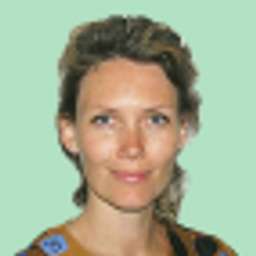

Why Book with Bookmundi
Earn USD 252+ in travel credits.
Best price guaranteed.
No credit card or booking fees.
100% financial protection.
Carbon neutral tours.
25,000+ trip reviews, with an average rating of 4.8 out of 5.
